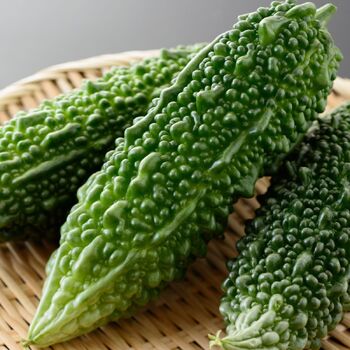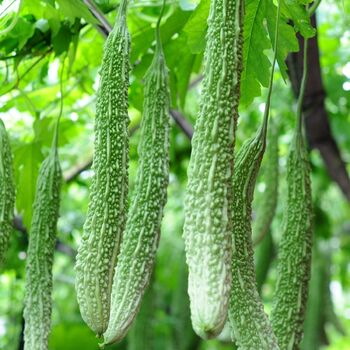
How to Grow Bitter Melon Seeds
Grow Guide #2233
Family: Cucurbitaceae
Binomial name: Momordica charantia
Life Cycle: Annual
This 'How to Grow' guide details everything a home gardener needs to know to plant, grow and care for Bitter melon (Momordica charantia).
When to Sow Bitter melon Seeds
Bitter melon is a warm season crop. Use the table below to identify the best time of year to sow bitter melon seeds in your climate.
| JAN | FEB | MAR | APR | MAY | JUN | JUL | AUG | SEP | OCT | NOV | DEC | |
|---|---|---|---|---|---|---|---|---|---|---|---|---|
| Cool | ||||||||||||
| Temperate | ||||||||||||
| Sub-Tropical | ||||||||||||
| Tropical | ||||||||||||
| Arid |
Preparation
Bitter melon plants are best grown in full sun. Choose a location that will receive at least 6 hours of full sun each day.
Bitter melon plants need a well drained soil enriched with plenty of organic matter. Prepare soil by weeding it thoroughly, digging it over to loosen it and adding aged animal manure or compost. Keep the area free of weeds until planting. Learn more about preparing soil for planting here.
How to Sow Bitter melon Seeds
Scarifying seeds prior to planting will improve the speed and success of germination. Scarification involves intentionally damaging the hard outer coating of the seeds to allow water to reach the seed's embryo. Use a sharp knife to make a shallow nick in each seed's shell, or gently wear away a section of the husk using fine sandpaper or a nail file. Read more about scarification here. Alternatively, soak seeds for 12-24 hours prior to sowing to soften the seed coat.
Bitter melon seeds grow best when they are sown directly into the garden.
- Sow seeds directly in the garden 15mm deep and 60cm apart, with rows 130-160cm apart.
- Keep soil moist but never wet or dry.
- Seeds should germinate in around 10-15 days at a soil temperature of 25-32°C.
- Young seedlings will need protection from pests, pets and weather until they are established.
Bitter melon is a tender crop that’s sensitive to frost. Do not transplant seedlings or sow seeds outside until all danger of frost has passed.
How to Grow Bitter melon
Bitter melon plants may need watering during the growing season. Water when the soil is dry about 5cm below the surface (test this by scratching away a little soil with your finger). Water deeply in the early morning or late afternoon. Avoid watering the leaves of plants to avoid fungal diseases. Learn more about watering here.
If soil was well prepared no extra fertiliser should be necessary. In poor soil or to give your plants an extra boost, application of a balanced fertiliser or one formulated for fruit and vegetables can be beneficial:
- Apply slow release fertiliser at the recommended rate when transplanting or when seedlings are 5-10cm tall.
- Apply liquid fertiliser at the recommended rate and frequency while plants are fruiting or flowering.
Vines can sprawl along the ground or be grown up a strong trellis. If growing on the ground, allow at least 2 square metres per plant. If growing on a trellis, plants will attach themselves using their tendrils but extra support can be provided by tying plants gently using twine or plant ties. Make sure you have the support in place when you sow seed or transplant seedlings to avoid disturbing the plant’s roots later.
How to Harvest Bitter melon
Bitter melon should be ready to harvest in approximately 75 days.
Fruit is ready to harvest when the skin is glossy and the fruit is large enough to eat. Harvest fruit when tender and young as older fruit can become unpalatable. Harvest fruit by cutting it from the vine or bush, leaving a small amount of stem attached. Store bitter melon in a perforated plastic bag in the fridge.
Common Problems when Growing Bitter melon
Like all plants, bitter melon is susceptible to some pests, diseases and other problems. Below is a list of the most common problems gardeners encounter when growing bitter melon plants:
 Aphids are small (2-4mm long) sap-sucking insects that congregate on the new shoots or the undersides of leaves. They can cause leaves to wilt or become discoloured, and also excrete honeydew which can attract ants and other insect pests. To manage aphids, remove them by spraying with a garden hose, apply a soap or alcohol spray, or encourage predatory insects to your garden. Read more about aphids here.
Aphids are small (2-4mm long) sap-sucking insects that congregate on the new shoots or the undersides of leaves. They can cause leaves to wilt or become discoloured, and also excrete honeydew which can attract ants and other insect pests. To manage aphids, remove them by spraying with a garden hose, apply a soap or alcohol spray, or encourage predatory insects to your garden. Read more about aphids here..jpg) Not setting fruit is a problem caused by lack of pollination. Flowers may fall off the plant or small fruit may form but then shrivel and rot. Wait until the plant is producing both male and female flowers. Use a paintbrush to transfer pollen from the male flowers to the female ones. Learn more about hand pollination here..
Not setting fruit is a problem caused by lack of pollination. Flowers may fall off the plant or small fruit may form but then shrivel and rot. Wait until the plant is producing both male and female flowers. Use a paintbrush to transfer pollen from the male flowers to the female ones. Learn more about hand pollination here.. Possums, birds and other animals can ruin a large percentage of your harvest overnight. Physically exclude pests by using netting or cages, or try spraying plants with a pungent homemade spray made from garlic, fish oil or mustard.
Possums, birds and other animals can ruin a large percentage of your harvest overnight. Physically exclude pests by using netting or cages, or try spraying plants with a pungent homemade spray made from garlic, fish oil or mustard..jpg) Powdery mildew is caused by fungal spores reproducing on the leaves of plants. First showing as white spots on leaves, affected areas can spread quickly to cover the entire leaf surface. While rarely fatal, powdery mildew can reduce yields. Water plants at soil level (not on leaves) to prevent spreading spores, allow good air flow between plants, remove affected leaves and if necessary spray with an appropriate fungicide or homemade spray. Read more here about powdery mildew here.
Powdery mildew is caused by fungal spores reproducing on the leaves of plants. First showing as white spots on leaves, affected areas can spread quickly to cover the entire leaf surface. While rarely fatal, powdery mildew can reduce yields. Water plants at soil level (not on leaves) to prevent spreading spores, allow good air flow between plants, remove affected leaves and if necessary spray with an appropriate fungicide or homemade spray. Read more here about powdery mildew here. Sunscald will show up on fruit as white marks or blisters that often become moudly. Young, unripe fruit are most susceptible. Do not prune leaves from plants at the height of summer; leaves will help to shade and protect the fruit. Cover plants with a light fabric on very hot days to protect them from sunburn.
Sunscald will show up on fruit as white marks or blisters that often become moudly. Young, unripe fruit are most susceptible. Do not prune leaves from plants at the height of summer; leaves will help to shade and protect the fruit. Cover plants with a light fabric on very hot days to protect them from sunburn.


.png)






